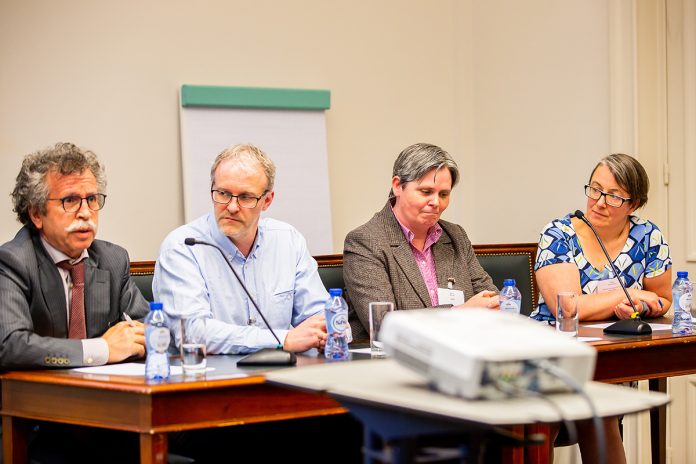Dr Dimiter Prodanov from IMEC sheds light on the governance of emerging nano-risk in the semiconductor industry in this summary workshop report
An increasing number of engineered nanomaterials (ENMs) are entering the market in everyday products, from healthcare and leisure to electronics, cosmetics, energy, agriculture, food and transport. Whilst for bulk chemicals, there are established regulatory frameworks dealing with the risk for the consumers, workers and the environment, this is not the case for nanomaterials. This situation has created a vivid community of nanosafety research, with the primary objective of ensuring that society can use nanomaterials safely and with confidence.
On 26th of April 2018, more than 40 representatives of stakeholder communities gathered in Brussels to discuss the risk assessment and governance framework of nanomaterials that are used in semiconductor industry. The workshop, entitled “Governance of emerging nano-risk in semiconductor industry”, was organised by two H2020 projects – NanoStreeM and caLIBRAte with the support of the Royal Belgian Academy for Arts and Sciences, Flanders.
Nanoelectronics was selected as an interesting use case for risk assessment approaches, due to its rapid innovation cycle and culture of high-profile health, safety and quality management. Moreover, nanoelectronics is one of the key enablers for industrial development and is responsible for 200,000 jobs in Europe and approximately 1 million indirect jobs. Therefore, risk management paradigms adopted by nanoelectronics can have widespread social and economic impacts.
The workshop programme featured three sessions focusing on:
(1) nanomaterial use in the semiconductor industry;
(2) industrial needs and technology advances in risk management;
(3) experiences in risk management from nanomaterials producers and downstream users.
Every session was followed by a moderated discussion by a separate discussion panel of experts, who also took questions from the audience. The workshop profiled 10 invited speakers and 11 panellists from academia, public research institutions, industry and the European Commission. While the present article can give only a brief summary of the event, readers are invited to visit the workshop web page and follow the recorded sessions and panel reports.
The workshop fostered a culture of open and lively discussions. Throughout the day, the following challenges were identified:
There appears to be an exponential growth of ENM entering the market worldwide. This presents both a vital opportunity for rapid economic development and a potential issue in presenting unanticipated hazards.
It is difficult to reliably predict the hazards and risks related to the use of new nanomaterials. Because of the exponential trend in new materials, the relative lack of resources makes the regulatory approaches challenging.
There is a clear safety knowledge gap, notably in emission and exposure assessments. Furthermore, toxicity data about nanoforms of nanomaterials are frequently lacking or are of poor quality.
Many nanotoxicity databases developed to date are not available for public use or the available data covers only a few materials.
Risk analysis is still technically and methodologically limited. Notably, the available models are very generic and difficult to adapt for everyday use by the industries.
The panellists and the audience discussed a broad range of questions concluding on two pertinent ones:
How can the regulatory framework be adapted to account for the long delays in availability of toxicological and environmental data on nanomaterials, without slowing innovation that comes with the application of these materials?
Discussions confirmed that conventional chemical risk assessment methodology is not adequate for newly developed materials or nanoforms entering the market. It can be concluded that nanomaterial risk assessment requires specialised knowledge in toxicology, exposure, emissions and lifecycle, which is not readily available at present outside academic communities.
The complexity of the subject and the substantial time lags when data becomes publicly available poses a definite regulatory challenge. In this perspective, it is very important to build competences and scientific capacity that can streamline the translation from basic science to regulatory science. On the other hand, approaches for grouping of nanomaterials in similarity groups (i.e. such as hazard bands or classes), which are developed by some projects and stakeholder groups appear as a pragmatic methodology to advance. The health and safety assessment can be empowered by use of international standards, such as the ISO/TS 12901-2:2014. Furthermore, experience with proposed generic models to date does not favour a preference over one universal risk assessment framework versus multiple industry/application/material specific risk management tools.
How can upstream developers, suppliers and formulators cooperate with the downstream users in risk assessment guidance and risk management?
Risk acceptance along the supply chain depends strongly on the understanding of the chemical or nanomaterial hazards. Therefore, appropriate communication between the different actors along the supply chain is paramount for the successful management of emerging risks and hazards. The panellists agreed that the available regulatory frameworks, such as the REACH Regulation, can be used to communicate the hazards of nanomaterials along the supply chain. This also includes harmonizing national regulations and providing concrete guidance on testing and data generation for regulatory purposes. It can be also concluded that labelling of nanomaterials can be helpful when suitable communication channels are established.
In conclusion, nanotechnology involves a growing number of industrial applications with a large actual economic impact. Nanotechnology is expected to become a key pillar of the European economy of innovation, so it is very important to foster an open culture of communication of identified hazards and risks to maximise its socio-economic impact. To this end, it is important to identify appropriate sources of information and foster communication channels and training opportunities for all actors along the supply chain.
Acknowledgement
The NanoStreeM project (Nanomaterials: strategies for safety assessments in advanced integrated circuits manufacturing) receives funding from the European Union’s Horizon 2020 Research and Innovation Programme under grant agreement n° 688794.
Please note: this is a commercial profile
Dr Dimiter Prodanov, PhD
IMEC
Tel: +32 162 818 40











